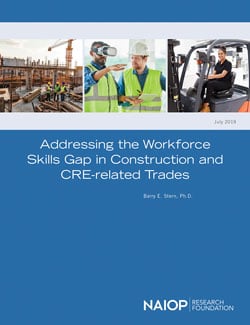
Skilled Labor: A Comeback Story
Shifting perceptions and education are key strategies.
The number of construction workers is shrinking across all sectors. Even with slight increases in entry-level hiring, the U.S. is losing skilled laborers faster than it can replace them with well-trained, journey-level craft professionals. The situation is even more worrisome considering that 41% of the current construction workforce is expected to retire by 2031, according to the National Center for Construction Education and Research (NCCER).
With declining interest in skilled trades and accelerated growth in areas such as technology, what are some possible solutions for the construction industry?
Demand Versus Supply
Construction demand in the U.S. continues to align with the needs of a rising population. And so, it is necessary to address the demand for more skilled labor entering the construction industry. According to a proprietary model developed by Associated Builders and Contractors, “The construction industry will need to attract an estimated 546,000 additional workers on top of the normal pace of hiring in 2023 to meet the demand for labor.”
Associated Builders and Contractors has found that every $1 billion spent on construction creates roughly 3,900 jobs. Government programs that provide funding to modernize bridges, roads and other infrastructure require skilled trade professionals.
The demand for qualified craft workers is growing in America, not shrinking. The interest in craft and trade training, on the other hand, has been declining for decades.
The cultural shift toward favoring four-year college degrees over skilled trades began in the 1960s, resulting in the perception that office or management roles are more attractive. This directly affected interest in high school technical programs, leading to the elimination of many of these programs during the late 20th century. Since then, the construction industry has struggled with a shortage of workers. Although a reemergence of trade programs in educational settings and union training programs is underway, overall interest in construction trade careers has waned because four-year degrees are heavily promoted to young people.
However, the perception of the skilled trades may be shifting.
Earning Potential
According to Statista, the average annual income for a college graduate with a bachelor’s degree in 2020 was $52,344. For the same year, the average annual income for a carpenter was $54,200, according to Forbes — and the variety of trade certifications available continues to expand.
Despite the evidence pointing to the earning potential and educational cost savings of the construction trades, they are still stigmatized as being dirty, grungy and labor intensive. Although physical labor is a component of many hands-on construction jobs, a variety of opportunities exist where shirts and shoes remain dirt free. Many construction and trade careers offer comprehensive benefits, career growth and increased earning potential. Some offer promotional opportunities every three to four years as an industry standard.
Education and Apprenticeships
Construction companies of all sizes, trade associations and educational institutions are working to deconstruct the stigma around the trades to help build a skilled labor pipeline.
Community colleges have expanded their curricula and match technical schools in the trade programs being offered, with many being quite affordable. Some institutions are also interested in partnerships with local companies to create programs tailored to their needs. In North Carolina, Duke Energy donated $500,000 to create a utility line worker training program at Central Piedmont Community College, addressing a statewide need.
Companies, colleges and organizations such as Associated Builders and Contractors (ABC), the Associated General Contractors of America (AGC) and SkillsUSA are informing K-12 students about the career opportunities in construction. These organizations offer a variety of apprenticeship programs developed by industry leaders. However, the availability of these programs varies by state and region and is often driven by member demand.
For companies seeking to establish in-house programs, curricula from resources such as NCCER are available to teach workers a variety of construction skills, including carpentry and plumbing. National general contractor and construction manager Swinerton uses a mixture of the NCCER curriculum and in-house expertise to train its 2,100 craft professionals, apprentices and superintendents. For employee-owned companies such as Swinerton that employ skilled craft professionals directly, investing in such programs attracts and retains quality talent.
Top construction companies are deploying several initiatives to improve their workforce, acquire skilled workers, increase the skilled labor pool and positively affect the industry overall. These initiatives include the following:
- Investment in employee education, growth and development.
Developing internal training programs to build skills among the most recent generation of employees, including those with the least amount of exposure to construction, is beneficial in teaching the technical skills for the job. Internal training programs also benefit the company because they build a culture of knowledge-sharing and professional development that can bridge generations. - Partnerships with organizations and educational institutions that promote trades.
Construction-focused organizations such as ABC and AGC are creating programs based on the needs of their members to raise awareness of the benefits and opportunities provided by construction careers, as well as offering valuable training. - Ambassadors to K-12 programs.
Keeping K-12 students informed of training opportunities in construction can work to effectively diffuse the stigma associated with construction trade career paths. It also can educate future generations about the benefits associated with such opportunities.
No effort to expand the pool of construction workers is too big or too small. Every positive interaction, association or experience with a potential future skilled tradesperson increases awareness and the likelihood that an individual will choose a career in construction — and that outcome benefits the industry and the economy.
Joshua Doty is a field talent partner at Swinerton.
|
|
RELATED ARTICLES YOU MAY LIKE

Revitalization and Revenue: Office Conversions as a Way to Rebuild Cities
It’s not a panacea, but reuse can inject life into business districts.
Read More
Facility Managers Must Prepare for an All-Electric Future
Before that, many commercial buildings could benefit from hybrid electrification.
Read More
Developers Can Cash Out Tax Credits for Renewable Improvements
A major change to the tax code could greatly incentivize green construction in commercial real estate.
Read More




